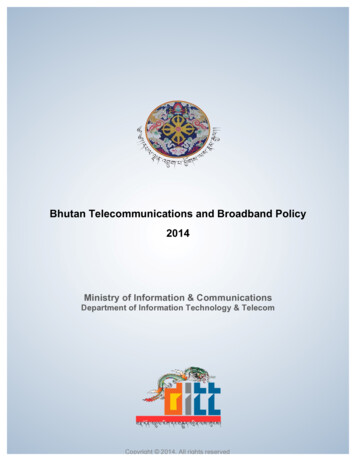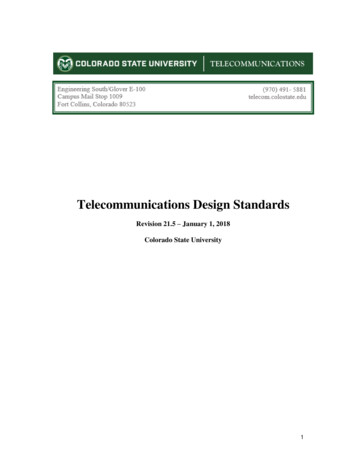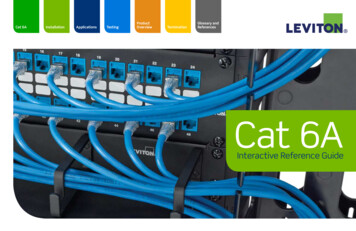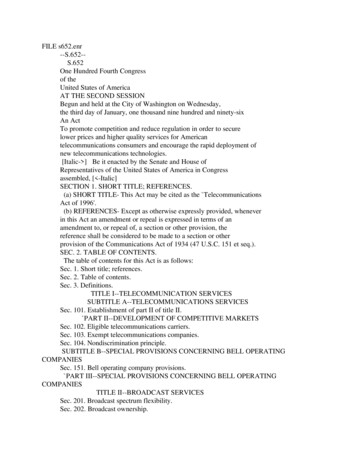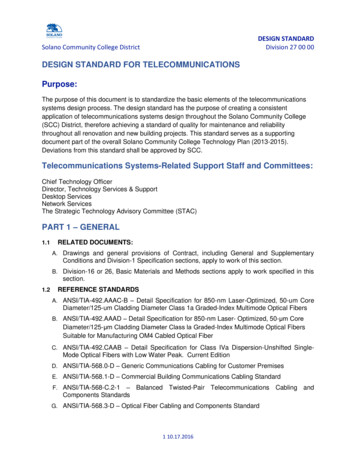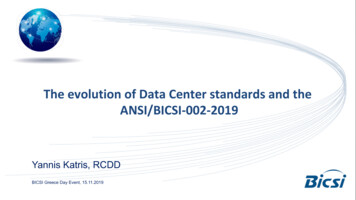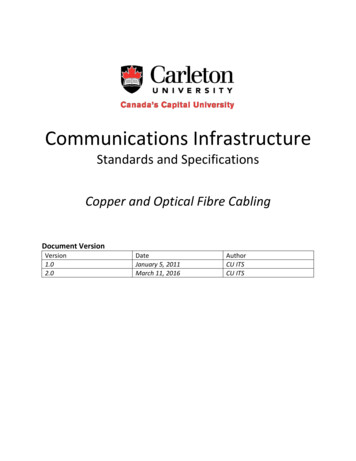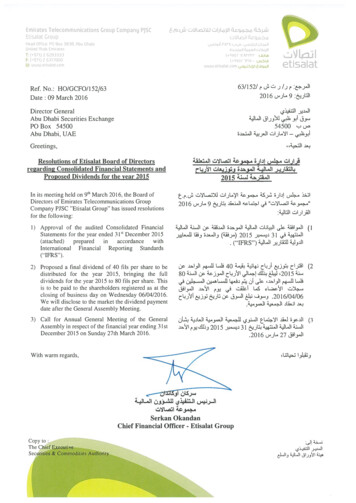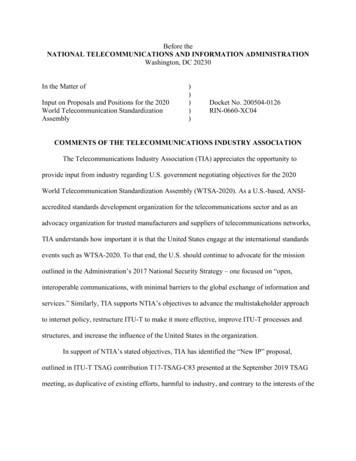
Transcription
Before theNATIONAL TELECOMMUNICATIONS AND INFORMATION ADMINISTRATIONWashington, DC 20230In the Matter ofInput on Proposals and Positions for the 2020World Telecommunication StandardizationAssembly)))))Docket No. 200504-0126RIN-0660-XC04COMMENTS OF THE TELECOMMUNICATIONS INDUSTRY ASSOCIATIONThe Telecommunications Industry Association (TIA) appreciates the opportunity toprovide input from industry regarding U.S. government negotiating objectives for the 2020World Telecommunication Standardization Assembly (WTSA-2020). As a U.S.-based, ANSIaccredited standards development organization for the telecommunications sector and as anadvocacy organization for trusted manufacturers and suppliers of telecommunications networks,TIA understands how important it is that the United States engage at the international standardsevents such as WTSA-2020. To that end, the U.S. should continue to advocate for the missionoutlined in the Administration’s 2017 National Security Strategy – one focused on “open,interoperable communications, with minimal barriers to the global exchange of information andservices.” Similarly, TIA supports NTIA’s objectives to advance the multistakeholder approachto internet policy, restructure ITU-T to make it more effective, improve ITU-T processes andstructures, and increase the influence of the United States in the organization.In support of NTIA’s stated objectives, TIA has identified the “New IP” proposal,outlined in ITU-T TSAG contribution T17-TSAG-C83 presented at the September 2019 TSAGmeeting, as duplicative of existing efforts, harmful to industry, and contrary to the interests of the
United States. 1 Other proposals have been made in various ITU study groups that are directlyrelated to this "New IP" effort, and link it to the research work of Focus Group Technologies forNetwork 2030 (FG NET-2030), which was created in July 2018 by Study Group 13. 2 The NewIP proposals make a series of arguments advocating for a new suite of networking protocolsfollowing a top-down design, based around alleged shortcomings of the existing TCP/IP-basednetworks. The new proposal, according to proponents Huawei and the Chinese government,promises to provide better support for heterogeneous networks that more efficiently combinesatellite and terrestrial signals, deliver better performance, increase security, and supportfuturistic applications such as “holographic-type” communication.TIA believes that NTIA and the U.S. government should oppose the New IP proposal andrelated initiatives for the following reasons:1. New IP duplicates work being done in the IETF and other standards bodies2. New IP poses practical and technical challenges3. New IP works against the multi-stakeholder approach to the InternetTo the extent that work being done to address substantive technical concerns identified by theauthors of the New IP proposal, TIA believes that it should be conducted in multi-stakeholder,inclusive forums with experience developing internet protocols such as the IETF. Additionally,proposals to reform or change IP protocols should avoid reproducing monolithic, top-downarchitectures like those advocated for in the New IP proposal.Int’l Telecomm. Union [ITU], “New IP, Shaping Future Network”: Propose to Initiate the Discussion of StrategyTransformation for ITU-T, TSAG-C83 (Sep. 10, 2019), https://www.itu.int/md/T17-TSAG-C-00832Int’l Telecomm. Union [ITU], Network 2030: A Blueprint of Technology, Applications and Market Drivers Towardsthe Year 2030 and Beyond, White Paper, FG-NET-2030 (2019), cuments/White Paper.pdf12
New IP duplicates work being done in the IETF and other standards groupsWhile some elements of the New IP proposal are fundamentally flawed and should not bepursued in the context of international standards development efforts, other elements of theproposal do have some merit and in fact are already being pursued in other standardsdevelopment contexts. For example, the issue of integrating satellite and IP terrestrial networksis not new and has been addressed as far back as 1999 by the IETF in RFC 2488, whichdescribes TCP over satellite channels. 3 IETF continues to have a working group focused onmoving this technology forward through the application of QUIC network protocols for satellitecommunications which touch specifically on the question of a non-TCP protocol’s integrationwith satellite communications. 4The New IP proposal laudably focuses on a need to reduce latency. From a standardsperspective, this work is ongoing at the IETF through initiatives such as Transport LayerSecurity (TLS); QUIC; Deterministic Networking (DetNet); and Low Latency, Low Loss,Scalable Throughput (L4S), among others. 5 3GPP continues to develop Ultra-Reliable LowLatency Communication (URLLC) standards for 5G, 6 and is collaborating with the 5G AllianceM. Allman, D. Glover & L. Sanchez. Enhancing TCP Over Satellite Channels Using Standard Mechanisms. IETF RFC2488 (1999), https://tools.ietf.org/html/rfc24884Response to “Liaison Statement on New IP, Shaping Future Network” IETF: DATATRACKER (Mar. 30, d.6See Study on Physical Layer Enhancements for NR Ultra-Reliable and Low Latency Case (URLLC), TechnicalSpecification, 3GPP (2018), ons/SpecificationDetails.aspx?specificationId 3498 (hereinafter [3GPP Specification]); see also Alan Weissberger, 3GPP Release 16 Update: 5GPhase 2 (including URLLC) to be Completed in June 2020; Mission Critical Apps Extended, IEEE (Oct. 6, -completed-injune-2020/33
for Connected Industries and Automation (5G-ACIA) with respect to the needs of wirelessindustrial automation and control systems. 7On a more fundamental level, however, the primary issue in terms of reducing latency isnot with flaws with existing IP protocols. Rather, it is an infrastructure issue. Consumers needmore base stations, more fiber, and more edge data centers – not more duplicative standards.New IP poses practical and technical challengesNew IP casts aside the existing Internet architecture – the product of billions of dollars ininvestment by companies around the world – in favor a new approach with uncertain technicalmerits. Many of the challenges identified in the paper have already been effectively tackled inexisting, widely-deployed protocols, for example: Universal encapsulation: Encapsulation technologies such as Geneve, GRE, L2TPv3,VxLAN are already extensible and deployed across thousands of networks worldwide. Itis unclear why these technologies, or future ones, are insufficient for future networkinguse cases. 8 Traffic steering and metadata carrying: Segment routing provides many of thesefunctions, and while still being finalized, is deployed across a number of large carriernetworks. 9 Multipath: Multipath concerns session/identity preservation across multiple networkproviders. Yet technologies such as iOS/MacOS, Linux, FreeBSD, and others have usedMultipath TCP for some time. More recently, Hybrid ICN and MP-QUIC are alsoaddressing this. 10 Determinism: Most prominently, IEEE 802.1 Time-Sensitive Networking standards havebeen designed to guarantee packet transport with bounded latency, low packet delay5G for Connected Industries and Automation, White Paper, 5G ALLIANCE FOR CONNECTED INDUSTRIES AND AUTOMATION(2019), ionen/Whitepaper 5G for ConnectedIndustries and Automation/WP 5G for Connected Industries and Automation Download 19.03.19.pdf8Encapsulation Techniques: Generic Network Virtualization Encapsulation, VXLAN Generic Protocol Extension, andNetwork Service Header, White Paper, CISCO (2014), rastructure/white-paper-c11-733127.pdf9See e.g., News & Blog Entries, SEGMENT ROUTING (2020), https://www.segment-routing.net/news/10Luca Muscariello, Cisco Advances Open-Source Hybrid Information-Centric Networking for 5G, Cisco (Feb. 19,2019), or-5g74
variation, and low packet loss on local and metro area networks. Applications such asaudio, video, and entertainment production are already deploying technology based onthese standards, In addition, the IETF currently is examining deterministic networking forlayer 2 bridged and layer 3 networks, which when completed, will see these deploymentsexpanding further. 11 As noted above, 3GPP continues its efforts to offer ultra-lowlatency capabilities. 12Given that the concerns raised by the New IP proposal are already addressed in existing efforts,the practical implications of amending the current Internet Protocol suite with non-interoperableprotocols should be seriously considered. By introducing a separate and monolithic top-downarchitecture for the internet, the New IP proposal would be significantly disruptive. Everythingfrom existing network operations to software, applications, and even the commerce enabled byexisting TCP/IP would be impacted. In addition to significant direct costs needed to develop anddeploy this new network protocol, replacing TCP/IP would necessitate new business andoperational agreements between thousands of independent network operators. Quality of serviceaspects of the proposal would also complicate existing regulatory frameworks in areas such aslicensing, competition policy, data protection, pricing, and universal service obligations. 13New IP imperils the multi-stakeholder approach to the internetThe New IP proposal as introduced in contribution T17- TSAG-C83 promises to create a“top-down design for the future network.” 14 This inversion of the Internet from a bottom-up,connected network to a centrally administered, top-down one is antithetical to the multistakeholder approach that continues to facilitate and enhance innovation. In addition to puttingSee Deterministic Networking (detnet), IETF: DATATRACKER (2020), https://datatracker.ietf.org/wg/detnet/about/See 3GPP Specification, supra note 6.13Hascall Sharp & Olaf Kolkman, Discussion Paper: An Analysis of the “New IP” Proposal to the ITU-T, INTERNET SOC’Y(2020), l-to-the-itu-t/14Int’l Telecomm. Union [ITU], “New IP, Shaping Future Network”: Propose to Initiate the Discussion of StrategyTransformation for ITU-T, TSAG-C83 (Sep. 10, 2019), ea95fe-fcd274e920ca11125
innovation at risk, the top-down design proposed in the New IP initiative stands in contrast toAmerican values. As a forthcoming research report prepared by Oxford Information Labs to theNorth Atlantic Treaty Organization (NATO) notes, New IP will enable “fine-grained controls inthe foundations of the network” through the implementation of Distributed Ledger Technologies(DLTs). In China and other authoritarian states, DLTs would likely be directly controlled by thegovernment. 15 The likely outcome of this would be a “more centralised, top-down control of theinternet and potentially even its users, with implications on security and human rights.” 16Advocating for international standardsThe New IP proposal aside, TIA supports continued and consistent U.S. governmentengagement with international standards development organizations including the ITU. Thisengagement is most effective when conducted in close cooperation with the private sector andwith U.S. standards development organizations. TIA looks forwarding to partnering with NTIA,the Department of State, NIST, and other U.S. government stakeholders on standards issues ofshared concern moving forward, and we encourage the further development of policies thatfacilitate maximum participation by U.S. entities in the development of global standards.By:Patrick LozadaDirector, Global PolicyAnna Gross & Madhumita Murgia, China and Huawei Propose Reinvention of the Internet, FIN. TIMES (Mar. 27,2020), -904d7095e0f216Stacie Hoffman, Dominique Lazanski & Emily Taylor, Standardising the Splinternet: How China’s technicalstandards could fragment the Internet, OXFORD INFO. LABS (2020) (forthcoming).156
TELECOMMUNICATIONS INDUSTRYASSOCIATION1310 N. Courthouse RoadSuite 890Arlington, VA 22201(703) 907-7700Filed: June 8, 20207
The Telecommunications Industry Association (TIA) appreciates the opportunity to provide input from industry regarding U.S. government negotiating objectives for the 2020 World Telecommunication Standardization Assembly (WTSA-2020). As a U.S.-based, ANSI-accredited standards development organization for the telecommunications sector and as an



